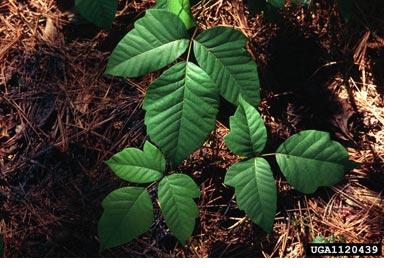 [S]
[S]
POISON IVY
by Grandpa Cliff Jan 1, 2005
 [S]
[S]
Eastern Poison Ivy ( Toxicodendron radicans )
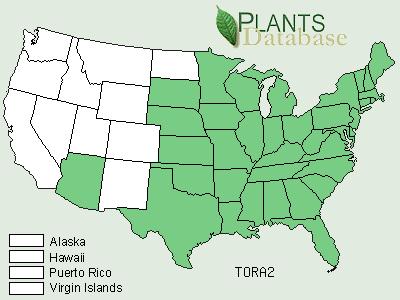 [S]
[S]
Contents
Poison Ivy Leaves
Poison Ivy in Spring
Poison Ivy in Autumn
Poison Ivy Stems & Aerial Roots
Poison Ivy on Trees
Poison Ivy on the Ground
Poison Ivy as a Shrub or Tree
Poison Ivy Flowers
Poison Ivy Fruits
Poison Ivy & People
___________________________________________________________________________________
POISON IVY LEAVES
Poison Ivy is a native plant that is not always easy to recognize, because some of its features can vary from plant to plant. Even leaves of a single plant can vary. You may have heard that Poison Ivy has three leaves, but that is not accurate. The photo above shows three Poison Ivy leaves, each of which has three leaflets. If a leaf has two or more leaflets it is called a compound leaf.
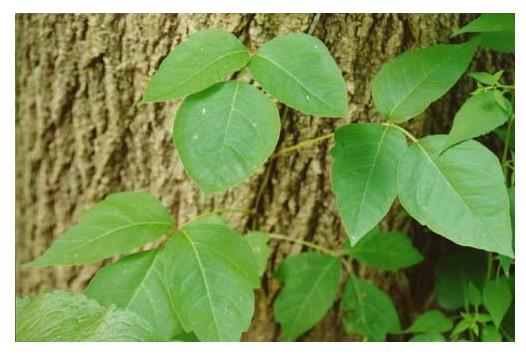
The two side leaflets have almost no stalk at all, while the leaflet at the tip has one that is long enough to be easily seen. The leaflets are all in about the same plane and are connected to the plant's viney stem by a long petiole (leaf stem). The photo (right) shows four Poison Ivy leaves. Three petioles, arranged alternately on the vine (instead of oppositely) can be seen. Petioles are sometimes reddish, although not in this photo.
Notice that the leaflets at 12:00 have smooth, toothless edges . Usually, however, there is one or more large teeth on a leaflet. The teeth may be pointed or rounded. Sometimes they may be large enough to resemble a lobe (photo directly below).
Teeth on Poison Ivy leaflets are never small like the serrations on a knife. They will be much larger than that.
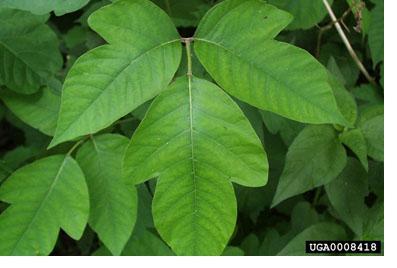
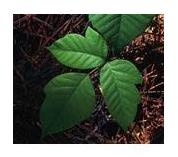
Side leaflets: Teeth can be lacking on the side leaflets, in which case the edge is called entire. Teeth can be on both edges, but most often the side leaflets have teeth on only the edge away from the tip leaflet. In those cases, it is common to have only one large tooth making each side leaflet look like a mitten with a thumb (see photos at left [S] and right [S]).
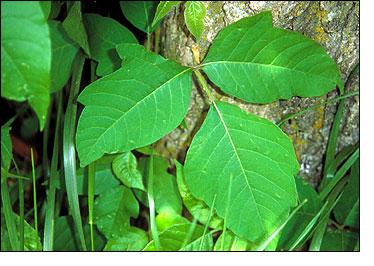
Side leaflets: one "mitten" and the other with two large teeth.
Tip leaflet: Teeth can be present or absent on the tip leaflet. If there are teeth, they are likely to be on both edges, but not always.
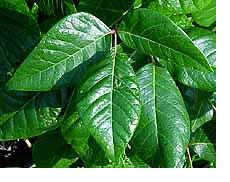
Poison Ivy leaflets sometimes have a very shiney upper surface. The leaves above on this webpage were not this shiney. These leaflets have no teeth.
[S]
POISON IVY IN SPRING
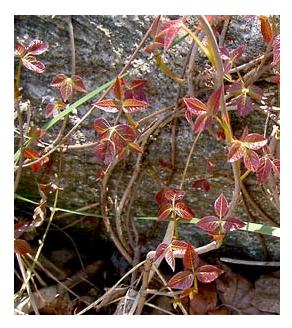

In northern United States and Canada, the leaves will drop off the Poison Ivy plant in Autumn. In the Spring, the new leaves that appear will be very shiney and reddish when they are small. The reddish color indicates the presence of anthocyanin in the cell vacuoles. As soon as the green chlorophyll begins to appear, the young leaves start to change color, because the green hides the red.
[S]
POISON IVY IN AUTUMN
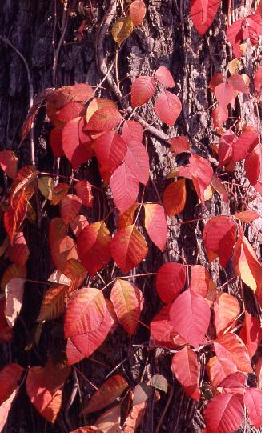
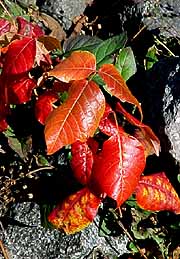
As the leaves grow and make chlorophyll, the green color hides the red. However, in the Autumn when the chlorophyll deteriorates just before the leaves fall off, the leaves may turn red again if they are in a sunny location. Some plants will have orange leaves instead of red. Poison Ivy can be a very colorful fall plant. In fact, it was imported by England and Australia because of its fall appearance.
The plant at the right has very shiney foliage. [S]
[S]
POISON IVY STEMS & AERIAL ROOTS
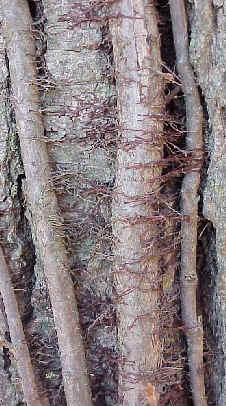

Eastern Poison Ivy is a long-lived, perennial plant that often grows as a climbing vine. The woody vine forms aerial roots that attach firmly to the tree trunk. Sometimes the the vine forms a great abundance of aerial roots as at the right. The color of young aerial roots is reddish, but they can darken with age.
[S]
[S]
POISON IVY ON TREES
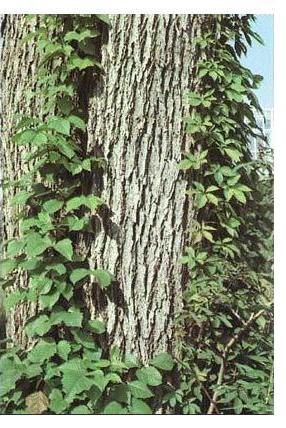
Instead of winding around a tree, it usually grows up just one side of the trunk. In the photo at the left, Poison Ivy is on the left, and Virginia Creeper is the vine on the right side. They often grow together. Both turn red in the fall.
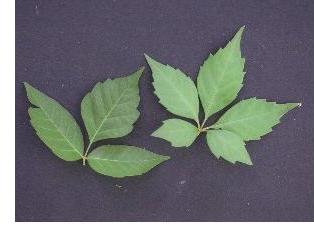
Although people get them confused with each other, they are easy to tell apart. At the right you can see one leaf of each (petioles were cut off). The Poison Ivy has three leaflets and white berries; Virginia Creeper has five leaflets and purple berries.
[S]
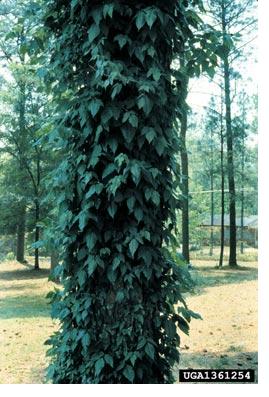
This could be a case of several Poison Ivy plants growing up the same tree. We cannot be certain by looking at the photo. [S]
POISON IVY ON THE GROUND
A Poison Ivy stem (vine) frequently grows along the surface of the ground, sometimes forming dense patches. I have very often seen it growing along the ground as much as 20-30 feet into a woods, in the partial sun 5-10 feet outside the woods in long grass, and along fences or rock walls where the grass does not get cut. In New York State, this form of Eastern Poison Ivy is much more common than that which grows up trees.
POISON IVY AS A SHRUB OR TREE
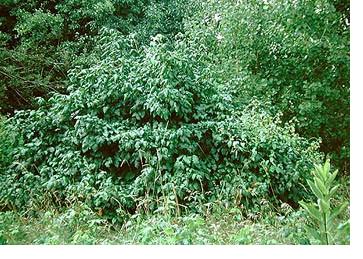 Poison
Ivy can also be a bush (left, [S]). Look at the same bush in Winter.
Look at a
close-up of another Poison Ivy bush.
Poison
Ivy can also be a bush (left, [S]). Look at the same bush in Winter.
Look at a
close-up of another Poison Ivy bush.
I once worked with a scientist who told me a very interesting story. While attending Iowa University prior to 1960, he was walking onto campus on a very hot day. This botany (plant) major decided to rest under a small tree to get out of the sun for a few minutes. Naturally, he tried to identify the tree. It turned out to be Poison Ivy or Poison Oak, both closely related plants that can be difficult to tell apart. I believe the story because I know the person. If it was Poison Ivy, in that location it might have been Western Poison Ivy ( Toxicodendron rydbergii).
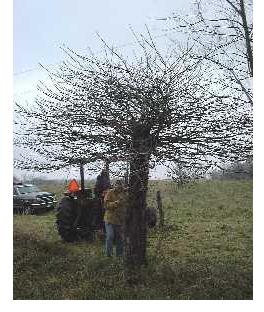
And here is a photograph of a possible Poison Ivy Tree in Virginia just before it was cut down. It looks like there are buds on the tree, so it may have been Spring.
The write-up that accompanied the photo said, "Yes, you saw it here first!! The poison ivy vines were so old that they turned into trees. I've never seen anything like it before. Since Kenny only gets poison ivy "a little bit" and I just have to look at it to get a severe rash, he did the honors of cutting it down and hauling it away. I still got poison ivy anyway." [S]
The abrupt top to the trunk of the tree suggests doubt about this being a Poison Ivy tree. The early buds resemble the buds of a maple tree. Perhaps this is a Box Elder (maple) which has three leaflets and is sometimes confused with Poison Ivy. If so, something happened to the top portion of the tree. Another possibility is that a tall, dead tree trunk was overgrown with Poison Ivy vines.
POISON IVY FLOWERS
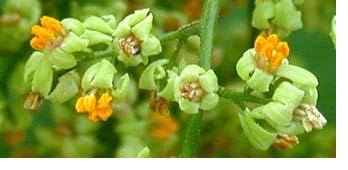
 Poison Ivy has small flowers with
five petals. They are
usually hidden below the leaves and not often noticed by people. The photo
at the left shows green petals and orange anthers. The flowers are much
larger than in real life. The petals at the right are white. Many
Poison Ivy plants do not flower every
year.
Poison Ivy has small flowers with
five petals. They are
usually hidden below the leaves and not often noticed by people. The photo
at the left shows green petals and orange anthers. The flowers are much
larger than in real life. The petals at the right are white. Many
Poison Ivy plants do not flower every
year.
[ S]
POISON IVY FRUITS

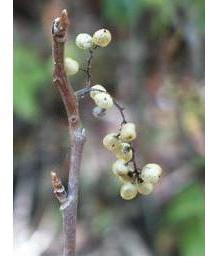
Poison Ivy flowers yield tiny, berrylike fruits. [Each is a drupe containing a pit within which is a single seed, like cherries and peaches.] The fruits are green at first, but become whitish when ripe. They are eaten by many species of birds. Deer, black bears, muskrat and rabbits will eat the leaves and stems as well as the fruits. Many animals do not have a bad reaction to Poison Ivy plants.
The pit can pass unharmed through the body of an animal and then be dropped at a new location where the seed can sprout. By this means, Poison Ivy can spread from one place to another.
POISON IVY & PEOPLE
Poison Ivy contains an oily allergin that can affect about 75-80% of the people. It can cause the skin of humans to blister, develop a rash, and undergo intense itching. The reaction to the oil normally lasts at least a week. The oil is in all parts of the plant and can affect a person whether the plant is alive or dead. Be aware that the oil can stay on gloves, clothes and footware for a year. Pets can even bring the oil into a home on their fur. The lungs of some people are severely affected by the smoke when Poison Ivy is burned.
Penn State University says that showering within five minutes of contact with soap and cold water will probably prevent a bad reaction. Hot water will open your pores and let the oil in, so it should be avoided. Taking a bath may spread the poison ivy to other parts of the body, so showering is much preferred.
Being immune to the Poison Ivy oil at an early age does not mean that a person will enjoy a lifetime of immunity. Many people will get it for the first time at an advanced age.

Once a person breaks
out with poison ivy, it is difficult to treat. One
natural remedy may be available before you can get home to a shower.
Spotted Jewelweed (Impatiens capensis), which is also called Touch-me-not, is common in Eastern New York
where I live; it is found in 41
states. The juice from the stem and leaves is said to have healing 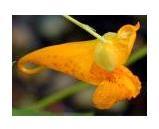 properties and has been used to fight the effects of poison ivy and insect
bites. The plant grows 2-5 feet high and has orange, trumpet-shaped flowers.
The thin, weak leaves often droop when sunlight is on them as in the photo at
the right.
properties and has been used to fight the effects of poison ivy and insect
bites. The plant grows 2-5 feet high and has orange, trumpet-shaped flowers.
The thin, weak leaves often droop when sunlight is on them as in the photo at
the right.
[left S]
On my own children, Jewelweed juice seemed to work once, but it did not work the second time. I am inclined to think that it can help if used soon after symptoms appear.
The dark-colored liquid formed from boiling the leaves and pieces of Jewelweed stems can be frozen in icecube trays up to a year for later use. A Jewelweed soap is even sold online.
Do not mistake any of the information in this section as being medical advice. I am not a doctor. One of the prescription steroids works very well, I am told. See a doctor if one is available. If not, Jewelweed juice would be worth a try.
_____________________________________________________
Visitors since 30 Dec 2006
Go to the HOME page